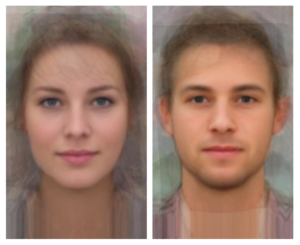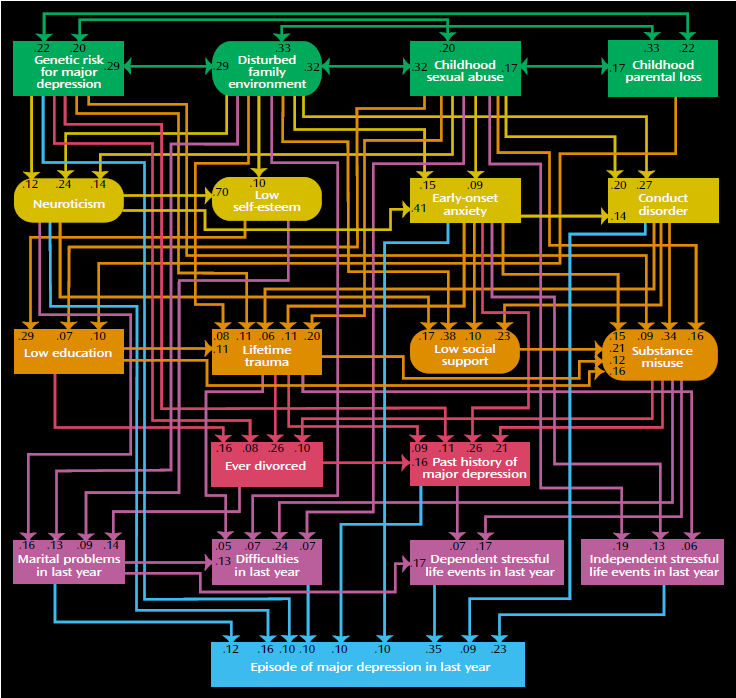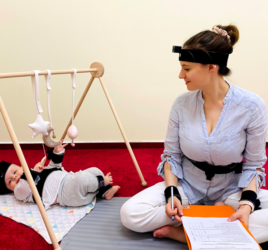
The development of psychopathology
In June 2016, Peter de Jonge was appointed Professor of Developmental Psychology. His research theme will be Developmental Psychopathology.
The average person does not exist. Take for instance these two pictures [1]. They represent the average Dutch woman and the average Dutch man, respectively. On the one side, you will recognize these faces as possibly belonging to persons living in the Netherlands. On the other side, you have never really met them.

The average Dutch woman and average Dutch man, respectively. Images retreived from http://facelab.org/.
In psychological research we tend to average across persons as well. Three examples: On average, women have a higher risk of depression than men; Persons with a lower level of education have higher risks of mental disorders; Individuals that underwent mindfulness therapy have on average fewer depressive complaints than individuals on a waiting list. Most knowledge we have in psychology is knowledge on the average person. How valid is this information when applied to real individuals? This is a question I am going to deal with in the years to come.
Heterogeneity and the development of psychopathology
Averaging across persons does not make much sense when persons differ strongly – this is called heterogeneity. The following is one example in which heterogeneity is evident: Traumatic experiences have been associated with the development of psychopathology. While many researchers may be interested in this association, I am looking for the exceptions to the rule. Why do some persons develop psychopathology after traumatic experiences while others do not (and even come out strong)? To answer this question, we will need information regarding the person’s personal trajectory of mental health during the life span. We will need to analyse which were the crucial steps in this trajectory that acted as turning points for this person. The data analytic techniques that can address these kinds of questions include time-series analyses and techniques that come from complex dynamic-systems analysis. They are not yet mainstream but they are techniques in which the researchers in my Developmental Psychology group are experts.
I hope to discover processes with which we can truly understand the development of psychopathology within individuals. After we have identified these processes, we can see how well these processes may generalize across persons. This is probably better than assuming that every person is interchangeable and that averages are good enough. In other words, I am not against generalization. In fact, I believe this is an important aspect of psychological science. I do think however that we need to know what we want to generalize, and that we need to account for heterogeneity. How my colleagues and I are tackling this issue with regard to the development of depression is outlined next.
Trajectories of psychopathology
An example of how we look at the aetiology of depression in a lifespan perspective is shown in the picture below. This picture is taken from the work of Professor Kenneth Kendler (Virginia Commonwealth University) [2][3]. While this model is quite complex and the data needed to develop such a model took an enormous effort, it explains up to 50% of all variance of depression. So if our aim is to fully understand why some persons become depressed and why others do not, we will need an even more complex model. I believe the limited explained variance signals that trying to capture all persons with depression in a single model falls short in really understanding the development of depression. In reality, there are many individuals for whom the aetiology of depression is really clear and easy: “I have never been depressed, but since my spouse died things have never been the same.”

Path and correlation estimates of the best-fitting model for predicting an episode of major depression in one year in 1,942 female twins. Image retrieved from Kendler, K.S., Gardner, C.O., Prescott, C.A. Toward a comprehensive developmental model for major depression in women. Am J Psychiatry. 2002 Jul;159(7):1133-45.
To illustrate an alternative to the model and procedure outlined: In our research project How Nuts Are The Dutch [4][5], we ask persons to complete questionnaires 3 times a day for 30 days in a row. This enables us to make ‘personal aetiological models’ – models based on a time-series analysis of each individual’s own data, representing questions like: “What factors are associated with or predictive of my own level of well-being?” This is a relatively new approach to the development of psychopathology on a person level. By now, we have personal etiological models of over 500 persons and the next step will be to see if there are generalizable processes going on.
In search for the mechanisms of developmental psychopathology, I will also look at life-course trajectories of mental health problems. Can we identify early onset forms of psychopathology that initiate a specific trajectory of mental disorders that persist during adulthood? For instance, we know that specific phobia often occurs for the first time in youth and that its onset is associated with various kinds of mental disorders later on in life. Can we identify specific trajectories of mental health and can we see turning points in a person’s history that determine what direction a person will go with respect to mental health?
These are the kind of questions I hope to address in the years to come, hopefully with the help of many talented and inspired students interested in understanding the development of psychopathology.
Relevant links and publications
NOTE: Image by Florian Straub, licenced under CC BY 2.0



